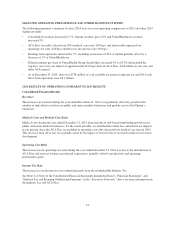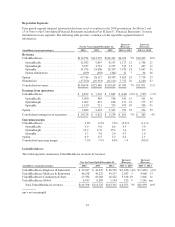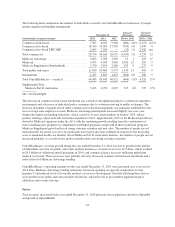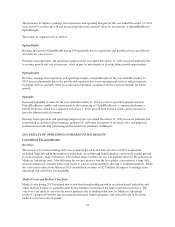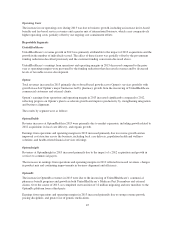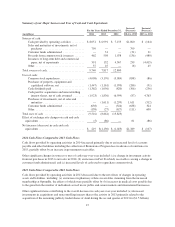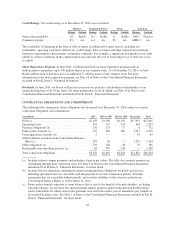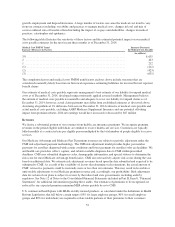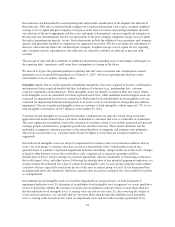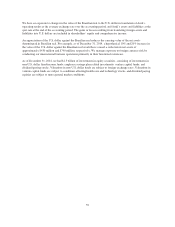United Healthcare 2014 Annual Report Download - page 52
Download and view the complete annual report
Please find page 52 of the 2014 United Healthcare annual report below. You can navigate through the pages in the report by either clicking on the pages listed below, or by using the keyword search tool below to find specific information within the annual report.(d) As the timing of future settlements is uncertain, the long-term portion has been classified as “Thereafter.”
(e) Includes obligations associated with contingent consideration and other payments related to business
acquisitions, certain employee benefit programs, and various other long-term liabilities. Due to uncertainty
regarding payment timing, obligations for employee benefit programs, charitable contributions and other
liabilities have been classified as “Thereafter.”
(f) Includes remaining capital commitments for venture capital funds and other funding commitments.
(g) Includes commitments for redeemable shares of our subsidiaries, primarily the shares owned by Amil’s
remaining non-public shareholders.
We do not have other significant contractual obligations or commitments that require cash resources. However,
we continually evaluate opportunities to expand our operations, which include internal development of new
products, programs and technology applications, and may include acquisitions.
OFF-BALANCE SHEET ARRANGEMENTS
As of December 31, 2014, we were not involved in any off-balance sheet arrangements, which have or are
reasonably likely to have a material effect on our financial condition, results of operations or liquidity.
RECENTLY ISSUED ACCOUNTING STANDARDS
In May 2014, the Financial Accounting Standards Board issued ASU No. 2014-09 “Revenue from Contracts with
Customers (Topic 606).” ASU 2014-09 will supersede existing revenue recognition standards with a single
model unless those contracts are within the scope of other standards (e.g., an insurance entity’s insurance
contracts). The revenue recognition principle in ASU 2014-09 is that an entity should recognize revenue to depict
the transfer of goods or services to customers in an amount that reflects the consideration to which the entity
expects to be entitled in exchange for those goods or services. In addition, new and enhanced disclosures will be
required. Companies can adopt the new standard using either the full retrospective approach, a modified
retrospective approach with practical expedients, or a cumulative effect upon adoption approach. ASU 2014-09
will become effective for annual and interim reporting periods beginning after December 15, 2016. Early
adoption is not permitted. We are currently evaluating the effect of the new revenue recognition guidance.
We have determined that there have been no other recently issued, but not yet adopted, accounting standards that
will have a material impact on our Consolidated Financial Statements.
CRITICAL ACCOUNTING ESTIMATES
Critical accounting estimates are those estimates that require management to make challenging, subjective or
complex judgments, often because they must estimate the effects of matters that are inherently uncertain and may
change in subsequent periods. Critical accounting estimates involve judgments and uncertainties that are
sufficiently sensitive and may result in materially different results under different assumptions and conditions.
Medical Costs Payable
Each reporting period, we estimate our obligations for medical care services that have been rendered on behalf of
insured consumers but for which claims have either not yet been received or processed and for liabilities for
physician, hospital and other medical cost disputes. We develop estimates for medical care services incurred but
not reported using an actuarial process that is consistently applied, centrally controlled and automated. The
actuarial models consider factors such as time from date of service to claim receipt, claim processing backlogs,
seasonal variances in medical care consumption, health care professional contract rate changes, medical care
utilization and other medical cost trends, membership volume and demographics, the introduction of new
technologies, benefit plan changes, and business mix changes related to products, customers and geography.
Depending on the health care professional and type of service, the typical billing lag for services can be up to 90
50



